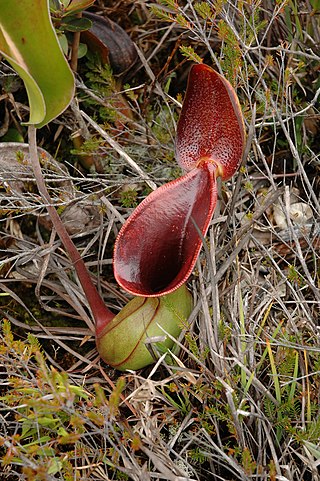
Nepenthes lowii, or Low's pitcher-plant, is a tropical pitcher plant endemic to Borneo. It is named after Hugh Low, who discovered it on Mount Kinabalu. This species is perhaps the most unusual in the genus, being characterised by its strongly constricted upper pitchers, which bear a greatly reduced peristome and a reflexed lid with numerous bristles on its lower surface.

Nepenthes fusca, or the dusky pitcher-plant, is a tropical pitcher plant endemic to Borneo. It is found throughout a wide altitudinal range and is almost always epiphytic in nature, primarily growing in mossy forest.

Nepenthes hurrelliana is a tropical pitcher plant endemic to Borneo, where it has been recorded from northern Sarawak, southwestern Sabah, and Brunei. It is of putative hybrid origin; its two original parent species are thought to be N. fusca and N. veitchii. A thick indumentum of rusty-brown hairs covers the entire plant, a characteristic presumably inherited from the latter.

Nepenthes benstonei is a tropical pitcher plant endemic to Peninsular Malaysia, where it grows at elevations of 150–1350 m above sea level. The specific epithet benstonei honours botanist Benjamin Clemens Stone, who was one of the first to collect the species.

Nepenthes lamii is a tropical pitcher plant endemic to New Guinea, where it grows at an altitude of up to 3520 m above sea level, higher than any other Nepenthes species. Although once confused with N. vieillardii and previously regarded as conspecific with the closely related N. monticola, it is now recognised as a distinct species.

Nepenthes jacquelineae is a tropical pitcher plant endemic to the Indonesian island of Sumatra. Due to its unique pitcher morphology, it is considered to be one of the most spectacular Nepenthes species native to the island.

Nepenthes dubia is a tropical pitcher plant endemic to the Indonesian island of Sumatra, where it grows at an altitude of 1600–2700 m above sea level. The specific epithet dubia is the Latin word for "doubtful".
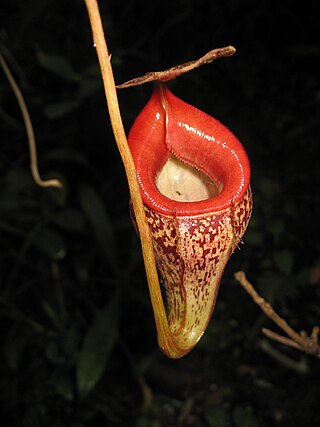
Nepenthes talangensis is a tropical pitcher plant endemic to Sumatra, where it grows in upper montane forest at elevations of 1800–2500 m above sea level.

Nepenthes rigidifolia is a critically endangered tropical pitcher plant endemic to Sumatra, where it grows at elevations of 1000–1600 m above sea level.
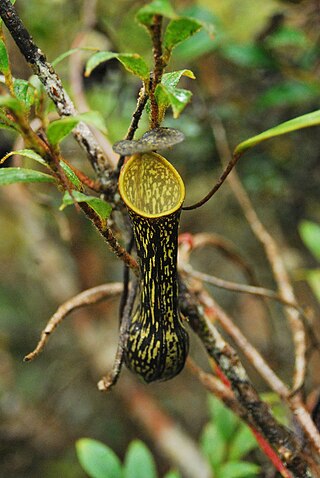
Nepenthes mikei is a tropical pitcher plant endemic to Sumatra. It is characterised by its black mottled lower and upper pitchers. The species is closely related to N. angasanensis and N. tobaica.

Nepenthes izumiae is a tropical pitcher plant endemic to Sumatra, where it grows in montane forest at 1700–1900 m above sea level. It appears to be most closely related to N. lingulata and N. singalana.

Nepenthes ovata is a tropical pitcher plant endemic to Sumatra. The specific epithet ovata is Latin for "ovate" and refers to the shape of the lower pitchers.
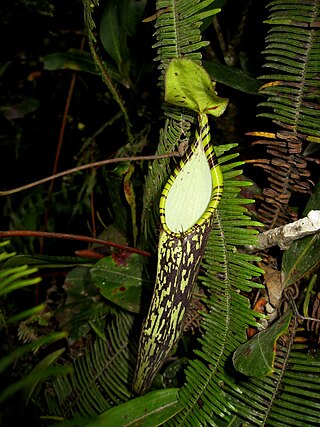
Nepenthes spectabilis is a tropical pitcher plant endemic to Sumatra, where it grows at elevations of between 1400 and 2200 m above sea level. The specific epithet spectabilis is Latin for "visible" or "notable".

Nepenthes jamban is a tropical pitcher plant endemic to northern Sumatra. The specific epithet jamban is the Indonesian word for "toilet" and refers to the shape of the pitchers.

Nepenthes micramphora is a tropical pitcher plant known only from Mount Hamiguitan on the island of Mindanao in the Philippines. It is a highland plant growing at elevations of 1100–1635 m.

Nepenthes pitopangii is a tropical pitcher plant endemic to the Indonesian island of Sulawesi. Discovered in 2006, N. pitopangii was initially known from a single plant at a remote locality in Lore Lindu National Park. Efforts made in the following years to locate further populations on surrounding mountains proved unsuccessful. In March 2011, a new population of N. pitopangii consisting of around a dozen plants was discovered more than 100 km from the type locality. Nepenthes pitopangii appears to be closely related to N. glabrata, from which it differs most obviously in its upper pitcher morphology.
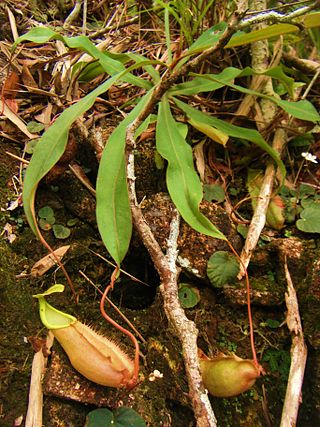
Nepenthes chang is a tropical pitcher plant endemic to the Banthad Mountains of central Thailand, where it grows at elevations of 300–600 m above sea level. It is thought to be most closely related to N. kampotiana.
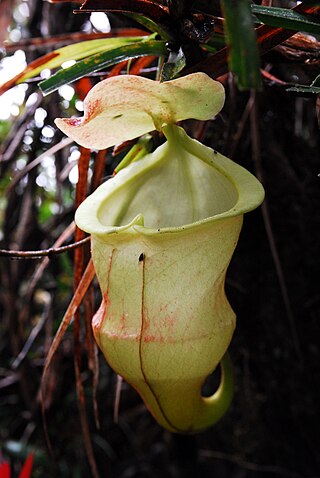
Nepenthes hamiguitanensis is a tropical pitcher plant endemic to a single peak on the Philippine island of Mindanao, where it grows at elevations of 1200–1600 m above sea level. Once thought to be a natural hybrid between N. micramphora and N. peltata, this plant is now considered a species of possible hybridogenic origin. It produces squat upper pitchers that vary greatly in pigmentation, from red speckled to yellow throughout.
Nepenthes sericea is a tropical pitcher plant endemic to the north-central Titiwangsa Range in Peninsular Malaysia and is particularly known from Cameron Highlands. Nepenthes sericea was distinguished from Nepenthes macfarlanei by its pitchers having a dense covering of filamentous lid hairs that are 2 mm long or shorter, whereas the latter has pitchers with numerous thickened lid hairs that are 5–12 mm long. Also, the upper pitchers of N. sericea can either be entirely infundibular or funnel-shaped with a slight narrowing just below the peristome, or some plants may have a mid-point hip in their upper pitcher with the rest of the pitcher turning cylindrical to sub-infundibular in shape above the hip. In contrast, the upper pitchers of N. macfarlanei are generally wholly infundibular and may or may not have a hip present just below the peristome.
Nepenthes ulukaliana is a tropical pitcher plant endemic to the southern Titiwangsa Range in Peninsular Malaysia. Nepenthes ulukaliana was compared to Nepenthes macfarlanei however, it exhibits several distinctions which include pitchers adorned with a dense covering of filamentous lid hairs measuring less than 1 mm long. Also, the lower pitchers of N. ulukaliana have an amphora-shaped to urceolate form. Furthermore, the peristome of N. ulukaliana is planar at the front, with a well-defined column that emerges abruptly and perpendicularly at the rear.

















